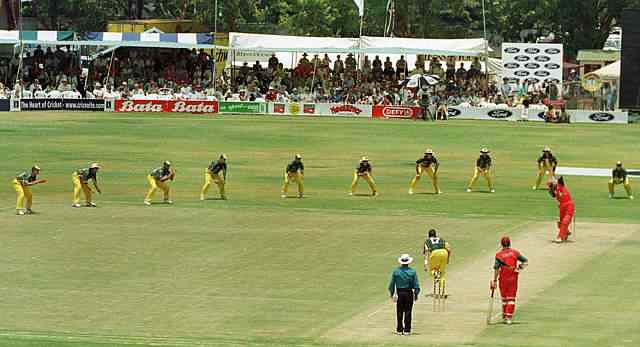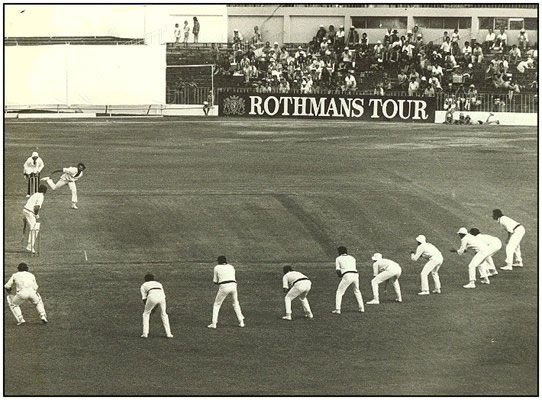Disclaimer: I mean no offence to baseball-lovers. The following is my attempt to explain some quirks of cricket by drawing parallels to baseball.
One of my stated hobbies on Orkut is “Memorising Cricket Statistics”. This may seem weird. Hell, it is weird. But it is fun. I guess it follows as an extension of liking both, cricket and numbers.
Most of my American friends find it difficult to understand an Indian’s obsession with cricket, the same way most Indians (and in fact, most non-Americans) find the attraction of Americans to baseball quite queer. To a bystander it does often seem funny that cricket is a game where you could play a match over 5 days and still not have a winner!
The Other Laws of Cricket
You have two sides, one out in the field and the other in the clubhouse. Each man that’s in goes out, and when he is out he comes in and the next player goes in until he is out. When all the players are out, the side that was out comes in and the side that was in goes out to get those players that are coming in out. Sometimes players are still in and not out. When a player goes out to go in, the players who are out try to get him out, and when he is out , he goes in and the next player in comes out and goes in.
There are two men called umpires who are all out all the time, they decide when the player who is in, is out. When both sides have been in and all players are out and both sides have been out twice after all the players have been in, including those who are not out, that is the end of the game.
Now do you understand cricket? To avoid complicating matters more, we haven’t got to the “silly mid on” and “sticky wicket” scenarios.
What, then, is the reason that a country of over a billion people obsesses over cricket? The reason is hard to pinpoint, though I believe that it is because individual brilliance in a team game is never showcased better than in cricket. Football (not the American breed) is the quintessential team game. In cricket, though, more often than not you have outstanding individuals in ordinary teams.
Then there is a question of skill. I know next to nothing about baseball, hence given my rudimentary understanding of the game baseball experts might find my knowledge of their game as superficial as a layman’s understanding of cricket. The little that I know of baseball tells me that you have to thump the ball as far as you can and run like your life depends on it. Cricket is different. Often it is not about thumping at all.
Douglas Jardine: Like most batsmen I can play one or perhaps two different shots to any given ball, whereas Bradman can choose between four or five.
Percy George Fender: Oh, he doesn’t choose. He just plays the first shot that comes into his head. But he has no technique. Now he can get away with it on those true hard Australian wickets. But put him on one of our green strips, with Morris, seaming the ball late… Oh no, he is too unorthodox. Now take the third test in Melbourne. On at least three occasions the ball was short-pitched, screaming out to be hooked. He played a cover-drive.
Douglas Jardine: At least two of those balls went for four. That is the power of Bradman. He’s learnt that the batsman’s sole objective is to score runs and he’ll play whatever shot, unorthodox or not, which best fulfils that purpose. It makes it almost impossible to set a field to him.
– From Bodyline – The Mini-Series
Every game is about scoring runs and getting the opposition down. Bradman happened to be the best batsman ever, but there have been several players for whom the above statements hold true. Now, would it be possible to say the same in a game like baseball? That is not to say that baseball-type slogging isn’t a part of the batsman’s repertoire in cricket. You do have some pretty brainless heaving exhibited by players like Shahid Afridi which would not be out of place in baseball.
There is, then, the whole different aspect of bowling. The very fact that you get to pitch the ball before it reaches the batsman opens up a new vista of options that would be quite out of place in baseball. You could have a bowler bowl really fast, the way you would ideally like to pitch in baseball and you could have the classic art of spin exhibited by slow bowlers to fox batsmen. Personally I like the sight of a menacing fast bowler sending down a thunderbolt to a batsman and the batsman promptly dispatching the ball to a corner of the field.
Greg Thomas was bowling to Viv Richards in a county game. Viv missed a superb outswinger, and Thomas said “It’s red, round and weighs about 5 ounces.”
Next ball Viv hits Greg Thomas out of the ground and replies, “Greg, you know what it looks like. Go ahead and find it!”
Running between the wickets is akin to running between the bases in baseball, I guess. But often it can lead to hilarious results due to a breakdown of communication on the field. Records of players like Inzamam-ul-Haq and Sourav Ganguly tell their own tales in this aspect.
“Bomber” Wells, a spin bowler and great character, played for Glocuestershire and Nottinghamshire. He used to bat at No.11 since one couldn’t bat any lower. Of him, they used to paraphrase Compton’s famous words describing an equally inept runner.
“When he shouts ‘YES’ for a run, it is merely the basis for further negotiations!” Incidentally, Compton was no better. John Warr said, of Compton “He was the only person who would call you for a run and wish you luck at the same time.”
Anyway, when Wells played for Gloucs, he had an equally horrendous runner as the No.10. During a county match, horror of horrors… both got injured. *Both* opted for runners when it was their turn to bat. Bomber played a ball on the off, called for a run, forgot he had a runner and ran himself. Ditto at the other end. In the melee, someone decided that a second run was on. Now we had *all four* running. Due to the confusion and constant shouts of “YES” “NO”, eventually, *all* of them ran to the same end. Note – at this point in time, the entire ground is rolling on the floor laughing their behinds out. One of the fielders – brave lad – stops laughing for a minute, picks the ball and throws down the wicket at the other end.
Umpire Alec Skelding looks very seriously at the four and calmly informs them “One of you buggers is out. I don’t know which. *You* decide and inform the bloody scorers!”
Harold “Dickie” Bird’s From the Pavilion End
While the batsmen and the bowler are in the thick of the action, the fielders too have their part to play. I don’t think catching the ball in baseball does the batter any harm (or does it?). In cricket it surely does. So a napping fielder often gets a good hiding from the bowler.
Fearsome English fast bowler Fred Trueman extracted an edge from the batsman, which flew straight into the hands of Raman Subba Row at first slip. The ball however went right between Row’s legs to the third man boundary. Fred didn’t say a word. At the end of the over, Row ambled past Trueman and apologised sheepishly. “Sorry Fred. I should’ve kept my legs together”. Trueman retorted in classic fashion “Not you, son. Your mother should’ve!”
Perhaps more than in any other game, the most thankless job is that of the umpires. Not only have the poor souls have to stand and watch an entire game, they also have to listen to at least one appeal each over (which makes it a good number of them in the course of a match) and then have each of their decisions scrutinised very thoroughly.
Lot of our appeals against the New Zealand players were turned down. Chandra in particular had a really bad time with a lot of legitimate decisions going against him.
He finally bowled the batsman out and turned to the umpire, “Howzaaaat?”
The umpire said, “He is bowled”.
Chandra’s reply was a classic, “I know he is bowled. But is he out?”
– Sunny Days by Sunil Gavaskar
The humour, though, is not restricted to the field. There can be a fair bit beyond the field too.
Jack Crapp, who was born on 14th October 1912, played seven Tests with reasonable success but is best known for the amusing, and possibly apocryphal, story of a misunderstanding with a hotel receptionist. When Crapp reported to the front desk, he was asked “Bed sir?” Presuming he had been mistaken for Alec Bedser, he replied, “No, Crapp.” The receptionist duly directed him to the first door on the right.
Well, this article has been the most unfit among the lot with the subject, “Eloi and Morlocks”. So what was my real motivation behind writing it? Nothing, I guess I just wanted to rant against baseball and show how cricket stands out in spite of or because of its idiosyncrasies!

